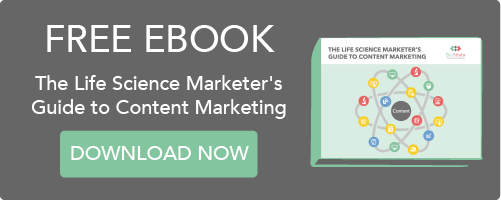So you’ve read our previous blogs and are thoroughly convinced of content marketing’s applicability to the life science realm. Not only that – you’ve also approached management and, after a BAFTA-worthy pitch, they’re now on board with the idea and excited for results.
But before developing a comprehensive and detailed content marketing strategy – and throwing yourself brand-first into the blogosphere – you need to research your buyer personas and have a clear understanding of who you’re writing for. Otherwise, your sparkly science content might not even reach your target readers in the first place.
Not all content formats are created equal.
In addition to researching the professional needs, wants and pain points of your company’s typical buyers, it’s worth thinking about the types of content format they’re most likely to respond to. Lucky for you, the internet is a multimedia wonderland and you’ve got an array of content formats literally at your fingertips.
Here are a few highly effective content marketing formats for life science buyer personas:
Educational blogs and guides
Blogs are the bread and butter of most content marketing strategies – and for good reason. When targeting a life science buyer persona, however, make sure that your blog content is sufficiently informative to be worth their time. Scientific professionals have been trained to analyse data, ask probing questions, and make rational and fact-based decisions. Educational blogs are a great way to build intellectual trust in your brand, and to develop thought leadership. Creating premium content eBook guides is also a great way to educate your reader, while engaging and building familiarity.
Data visualisation
Life science professionals are confronted with data on a daily basis. They’re comfortable with graphs, charts, and figures, and in this format. Incorporating visualisation in your content formats is an effective approach because it communicates information while speaking the language of the persona. Just make sure to keep your charts and graphs detailed enough to be interesting and informative, but simple enough to keep their attention and deliver key findings.
Infographics
While charts and graphs are both great ways to visualise data, an infographic goes one step further as a way to visualise information (often with ample use of data visualisation). Infographics are so effective because people find it easier to absorb information presented visually – not to mention they’re a lot more enjoyable to skim over than a wall of statistic-laden text. Infographics are also a great way to spice up dry subjects, using visual elements like colour schemes and illustrations to bring key facts alive. From a scientific content creation standpoint, infographics also force you to hone in on key information. Cutting away the fluff will strengthen your marketing messaging, leaving only the core components of the story you want to tell.
Peer-review papers and application-driven case studies
To really speak the language of your more scientific content marketing personas, consider investing resources into dedicated studies and peer-reviewed research papers. Doing so will give your brand scientific credibility, especially if the results benefit the wider scientific community. For more bottom-of-funnel content, an application-driven case study should do the trick. It’ll give you a chance to showcase your product in action – the more you can show your persona that your product or service is effective, the better. These content offerings will have considerably more impact if they use data and examples from your customers, rather than your internal experts. It’ll add to their authenticity, and provide valuable third-party validation.
Be sure to experiment with other content formats as well – you might be surprised at how well a specific buyer persona responds. But most importantly, always track your content performance so that you can make data-driven decisions in the future about which formats you should focus on.
To find out more about life science content marketing, download your free copy of The Life Science Marketer's Guide to Content Marketing.





